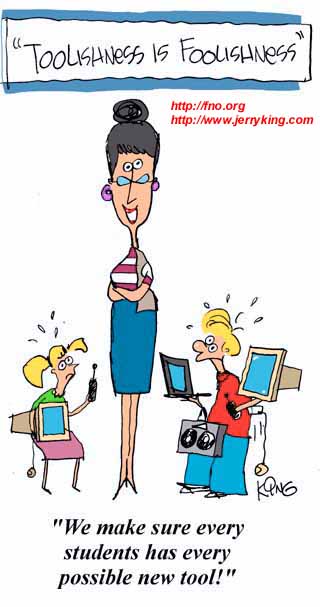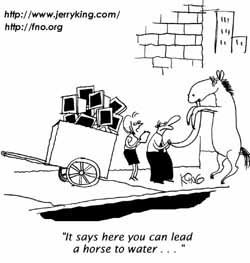Please feel free to e-mail this article to a friend, a principal,
a parent, a colleague, a teacher librarian, a college
professor, a poet, a magician, a vendor, an artist, a juggler, a
student, a news reporter or anyone you think might enjoy it.
Other transmissions not permitted (see copyright below).
|
Toolishness is Foolishness
by Jamie McKenzie
About the Author
It has spread far and wide . . . a fondness for tools that transcends purpose and utility . . . as when folks grab a hammer to paint a flower just because they like hammers or because hammers are trendy or when they allow a computer to speak for them to an audience instead of telling their stories with a natural voice or when people turn to search engines to find truths more likely to reside in books or their own hearts.
Toolishness is closely associated with other terms such as Foolishness, PowerPointlessness, MicroSoftness, Mentalsoftness™, Disneyfication, Edutainment and Infotainment.
We are emerging from several years of frenzied spending on new tools and new toys for the home, the workplace and the school - a frenzy that made many people rich but has also provided its share of disappointments.
The technology and dot com bubble seems to have burst as folks step back from the hype and the marketing to take a fresh look.
|

- Click here for an article on combatting mentalsoftness and glib thinking
- Click here for an article on combatting powerpointlessness
- Click here for an article on the disneyfication of information.
- Click here for an article on edutainment and infotainment.
|
"Take Away the Window Dressing, and Who Will Buy?"
By GRETCHEN MORGENSON (in the September 2, 2001 New York Times)
With the global economy in a stall, corporate spending at a standstill and layoffs threatening to subvert consumer spending, it is no surprise that the United States stock market is feeling overwhelmed.
But something else is weighing on stocks. That is the creeping realization among investors that the momentous earnings reported by many companies in recent years may have been digitally remastered to include a lot of hype, embroidery and fluff.
|
Schools have been swept up in the rush to network, placing millions of wired computers in classrooms around the globe before there was much evidence that they would see a return on these technology investments in the form of improved student performance. While these tools might, in fact, have a positive impact upon student performance, there is growing sentiment that such outcomes require a major commitment to human resource development - professional development and curriculum development along with support services - a commitment that has been made by very few districts.
 |
In many places, schools put the cart before the horse, planning and installing networks and computers before clarifying educational purpose and how these tools might be used.
A new tool comes along and classrooms are suddenly flooded.
"Why do I need this?"
The administrator smiles, "It's the newest thing and we are first!"
|
Schools are faced with a new digital imperative.
There is nothing wrong with bringing new tools into schools when we have determined that they might actually do some good by helping us to improve the reading, writing and thinking of our students, but in too many cases the tools and toys are purchased on a whim and a promise. In the past decade we have seen many new tools come and go. They arrive with big promises but fade with a whimper.
What are the indicators of toolishness? Take the quick survey below to see if your school or district may be vulnerable to this virus.
Check off the behaviors you have witnessed.
Indicators of Toolishness
| 1. No plan |
Without any planning or discussion with staff, the district suddenly announces a partnership with a vendor that includes the purchase of hundreds of new pieces of equipment such as personal assistants or hand held devices. |
... |
| 2. Figure it out |
The new tools are represented as the latest technology to improve classroom learning but when teachers ask how they are supposed to blend their use into their programs, they are told they can figure it out once the tools arrive. |
... |
| 3. Learn it on your own |
Except for a brief 2-3 hour introduction, teachers are expected to train themselves in the use of the new tools. The tools come with technical instruction booklets but little support for teaching and learning strategies. |
... |
| 4. A few good teachers |
Because there are not enough of the new tools to equip schools fully, volunteers are asked to pilot the use of the new tools. The same people always seem to volunteer, and their rooms (and closets) are always filled with new tools. |
... |
| 5. We are a leading district |
With the arrival of the new tools, a series of press releases announces the innovation in glowing terms. "We are the first district with digital playground swings!" |
... |
| 6. Oh, really? |
A few weeks into the use of the new tools, pioneering teachers discover that there are some problems, challenges and disappointments. They request help from administrators and vendors but get mostly shrugs. Battery life? Oh . . . |
... |
| 7. Declining expectations |
As the year progresses and classroom life settles into normal routines, the fanfare about the new tools subsides (as does their use). The daily press of classroom learning pushes the special effects and gimmicks to the side as teachers focus their efforts on activities that will do the most good. |
... |
| 8. Memory loss |
Some time during the first 24 months after the tools arrive, there is sudden memory loss. The promises, the prospects and the importance of the new tools have all been forgotten. If asked about these promises, key boosters will shrug and deny ever having made such claims. |
... |
| 9. The new new thing |
Just as dust begins to accumulate on the new tools, word begins to filter down through the ranks that a new technology is on the horizon and the district has a good chance to be a pioneer. |
... |
| 10. This is it! |
With plenty of fanfare, the district announces that it has been selected to lead the state or nation in the implementation of digital sandbox synthesizers. |
... |
|
©2001, J.McKenzie |
... |
What can we do?
School budgets are usually quite tight. Many schools have important capital needs like leaking roofs and aging electrical systems. If we are not careful, the pressure to close various "digital divides" (real or imagined) and the pressure to be a digital leader can distort spending agendas.
In order to buy the latest technologies, some districts cut back on libraries, library books, librarians, art programs, guidance counselors and other school expenditures that may be extremely important.
These budget decisions should be made with an eye toward results and consequences. We have reached the point where technology expenditures need to be challenged and questioned at the school level, the district level, the board level and the state level. Just as corporations are rethinking their investments in new tools and spending more cautiously, schools should be looking for ways to get the most results with economy and balance.
Schools that want to see results should spend more money on the professional development and curriculum development aspects of the innovation. Fewer tools. More learning.
|